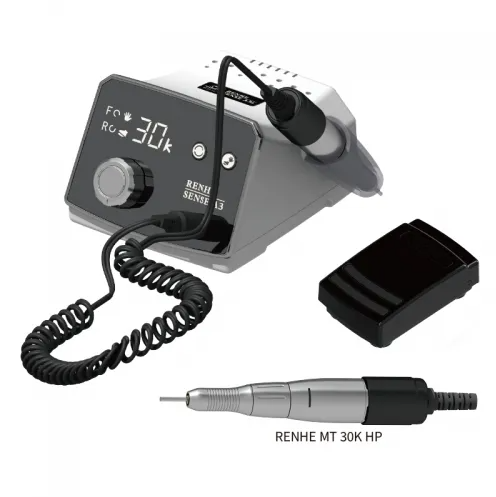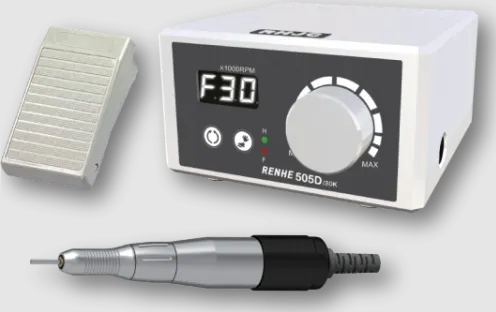Introduction
What is a Micromotor?
A micromotor is a compact, high-torque electric motor system used to drive rotary tools at precisely controlled speeds. Typically consisting of a control unit (power supply and speed control) and a handpiece (containing the motor and chuck mechanism), these versatile devices are indispensable in fields requiring detailed work, power, and precision. From intricate jewelry shaping to delicate dental procedures and precise nail art, the micromotor is a fundamental tool for professionals and serious hobbyists alike.
Why Choosing the Right Micromotor is Crucial
At first glance, micromotor systems may appear similar, but their internal specs and design details are finely tuned to their specific uses. A micromotor built for nail art, for example, won't have the power needed to grind dense metals in jewelry making—and trying to do so can lead to poor results or even damage. On the flip side, a heavy-duty jewelry micromotor could feel bulky or lack the finesse and hygiene requirements needed for dental or nail applications. Selecting the right micromotor for your specific needs in jewelry, dental, or nail art is not just about efficiency; it's critical for achieving high-quality results, ensuring user comfort, maintaining safety standards (especially in dental), and maximizing the lifespan of your investment. This guide will walk you through the specific demands of each field and the key parameters to consider.
Micromotor Needs for Jewelry Making
Common Tasks
Jewelers rely on micromotors for a wide range of demanding tasks, including:
• Grinding and shaping metals (gold, silver, platinum, etc.)
• Polishing surfaces to a high shine
• Drilling holes for settings or connections
• Stone setting preparation
• Engraving details
• Carving wax models for casting
Key Performance Requirements
The primary demands for a jewelry micromotor revolve around power and endurance:
• High Torque: Essential for efficiently removing material from hard metals without stalling.
• Durability: Must withstand prolonged use under heavy load and resist workshop dust.
• Variable Speed Range: Needs sufficient high-end speed for polishing but also controlled lower speeds for delicate tasks.
• Collet/Chuck Compatibility: Ability to hold various bur, drill, and polishing mandrel shank sizes (commonly 2.35mm, sometimes 3mm).
Recommended Micromotor Features
Look for these characteristics in a jewelry micromotor:
• Powerful Motor: Brushless motors are often preferred for their higher torque, longer lifespan, and consistent power delivery.
• Effective Heat Dissipation: Prevents overheating during extended grinding sessions.
• Stable and Robust Handpiece: Minimal vibration and runout (wobble) for precision, often slightly heavier to aid stability and house a stronger motor.

Micromotor Needs for Dental Applications
Common Tasks
In dental labs and clinics, micromotors are vital for:
• Trimming and finishing dental restorations (crowns, bridges, dentures)
• Cutting sprues and adjusting frameworks
• Polishing composites, ceramics, and metals
• Chairside adjustments
• Assisting in endodontic procedures (in specific low-speed applications)
Key Performance Requirements
Dental applications demand the utmost precision, hygiene, and reliability:
• High Precision & Stability: Minimal vibration and runout are critical for accurate work on small surfaces.
• High Speed Capability: Required for efficient cutting and finishing of hard dental materials.
• Smooth Operation: Low vibration ensures user comfort and control, crucial for fine adjustments.
• Autoclavable Handpiece: Non-negotiable requirement for sterilization to prevent cross-contamination. Handpieces must withstand repeated high-temperature steam sterilization.
• Medical-Grade Materials: Compliance with health and safety standards.
Recommended Micromotor Features
A suitable dental micromotor should possess:
• Precise Speed Control: Often with digital displays for exact RPM settings.
• Ergonomic, Lightweight Handpiece: Reduces fatigue during long procedures, designed for comfortable grip and control. Must be fully autoclavable.
• Low Noise Operation: Enhances patient and operator comfort.
• Reliability and Compliance: Built to rigorous medical device standards (e.g., ISO).

Micromotor Needs for Nail Artistry
Common Tasks
Nail technicians utilize micromotors (often called e-files or nail drills) for:
• Removing old polish, gel, or acrylic overlays
• Shaping and shortening natural or artificial nails
• Buffing the nail surface
• Cuticle care and refinement
• Creating intricate designs or preparing for embellishments
Key Performance Requirements
Comfort, control, and finesse are paramount for nail micromotors:
• Lightweight Handpiece: Essential for maneuverability and reducing hand fatigue during repetitive motions.
• Low Vibration: Critical for client comfort and technician control during delicate work near the skin.
• Fine Speed Control (Especially Low Speeds): Requires stability and control at lower RPMs for gentle buffing or cuticle work.
• Easy Bit Changes: Quick-release chucks are standard for efficiently swapping between different grits and shapes of nail bits.
• Comfortable Grip: Ergonomic design suited for pen-like holding.
Recommended Micromotor Features
Look for these attributes in a nail micromotor:
• Slim, Lightweight Handpiece: Designed specifically for nail technician ergonomics.
• Minimal Noise and Vibration: Prioritizes client and user experience.
• Forward/Reverse Rotation: Useful for working in different directions and for left/right-handed users.
• User-Friendly Controls: Simple speed adjustment and on/off functionality.

Comparing Key Micromotor Parameters Across Fields
Understanding how core specifications translate to application needs is vital for your choice. While specifics vary, the following table summarizes the general tendencies and priorities for each field:
| Feature / Parameter |
Jewelry Application |
Dental Application |
Nail Art Application |
| Typical RPM Range |
0 - 35,000 / 50,000+ RPM |
0 - 50,000+ RPM (Lab); Varies (Clinic) |
0 - 30,000 / 35,000 RPM |
| Primary Torque Need |
High |
Moderate to High (task-dependent) |
Low but Stable |
|
|
|
|
Comfort / Finesse |
|
|
|
|
Lightweight |
|
|
| No (Easy Clean Recommended) |
|
|
| Yes (Autoclavable Mandatory) |
|
|
No (Easy Clean/Disinfection Recommended) |
|
|
| Brushless Preferred (esp. Heavy Use) |
|
|
| Brushless Common (Pro Standard) |
|
|
Both (Brushless for Pro / Low Vibration) |
Note: RPM ranges are typical; specific tasks dictate precise speed needs. Priorities indicate primary focus areas.
Let's delve slightly deeper into some of these parameters:
Torque
As the table highlights, torque (rotational force) requirements differ significantly. Jewelry work, especially on platinum or other dense metals, demands the highest torque to prevent the micromotor from bogging down. Dental tasks require variable torque depending on the material, while nail applications prioritize smooth, consistent delivery even at low torque levels.
Handpiece Characteristics
Beyond the priorities listed in the table, ergonomics play a huge role too. For nail technicians, lighter is better to avoid fatigue. Dental professionals, however, need a handpiece that not only feels comfortable but can also handle frequent sterilization without wearing down. Jewelers often benefit from a slightly heavier, robust handpiece that aids stability during high-torque operations. The chuck mechanism for holding bits should also be considered – ease of change is vital for nail art, while secure locking is paramount for all applications.
Power Unit & Motor Type
The choice between brushed and brushless micromotors often comes down to usage intensity and budget, as reflected in the table's typical preferences.
• Brushed motors are simpler and less costly initially but require maintenance (brush replacement) and may offer less consistent torque and a shorter lifespan under professional use.
• Brushless motors, while a larger investment, provide superior performance, higher efficiency, greater torque consistency (crucial at low speeds too), significantly longer operational life, and reduced noise/vibration, making them the preferred choice for demanding professional environments in jewelry and dentistry, and increasingly popular among pro nail technicians seeking optimal performance.
Control boxes also vary, offering features like digital RPM displays, foot pedal compatibility (enhancing control in jewelry and dental work), overload safety circuits, and sometimes portability options.
Budget and Brand Considerations
Micromotor prices can vary a ton. While tempting, choosing the cheapest option is often false economy for professionals. Investing in a quality micromotor from a reputable brand known within your industry ensures better performance, reliability, safety (especially critical in dental), and longevity. Factor in the availability of warranty, customer support, and potential repair services when making your final decision.
Making the Right Choice: Final Considerations
At the end of the day, picking the right micromotor means knowing exactly what your craft demands—and matching those needs to the specs we've outlined:
• Jewelry: Prioritize Torque, Durability, and Robustness. Brushless motors are often the best investment.
• Dental: Focus on Precision, High Speed, Low Vibration, and mandatory Sterilizability. Medical-grade compliance is essential.
• Nail Art: Emphasize Low Vibration, Lightweight Ergonomics, and excellent Low-Speed Control.
Decision Checklist:
- Identify Primary Use: Which field (Jewelry, Dental, Nail) and what specific tasks dominate your work?
- Prioritize Key Features: Based on your tasks and the comparison table, what are the non-negotiables? (e.g., High Torque? Autoclavable? Lightweight?)
- Evaluate Handpiece Fit: Consider weight, grip, vibration, and ease of bit changes for your comfort and control. Does it match your field's priorities?
- Motor Type & Power: Does your usage intensity and need for performance/longevity justify a brushless micromotor?
- Set Budget & Research: Balance cost with required features and long-term value. Look into reputable suppliers known for quality micromotors.
Investing in the right micromotor pays dividends through improved work quality, increased efficiency, enhanced comfort, and, in regulated fields like dentistry, assured compliance and safety. Don't compromise on this essential tool.
For tailored advice or to explore high-performance micromotor options, including advanced brushless systems suited for your specific professional application, consulting with knowledgeable RHJC suppliers is highly recommended. They can help match your detailed needs with the perfect micromotor system.


